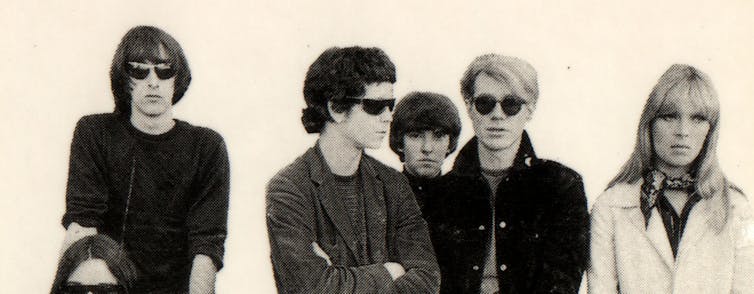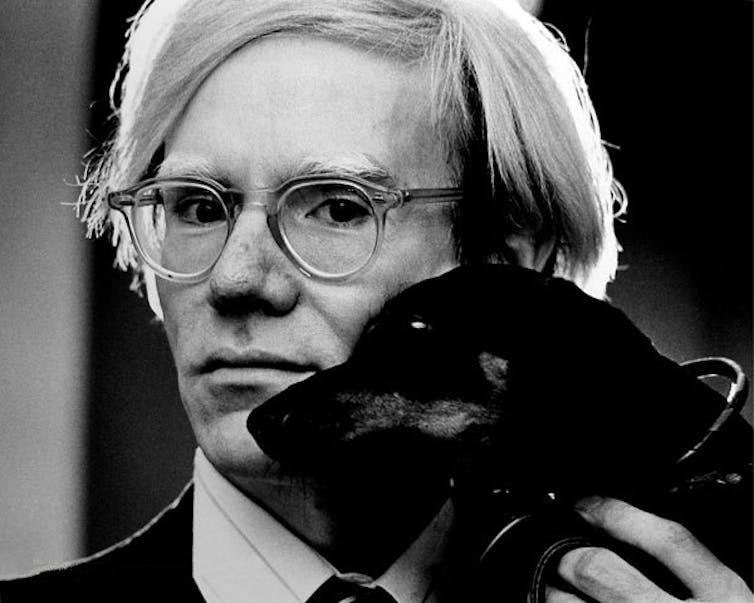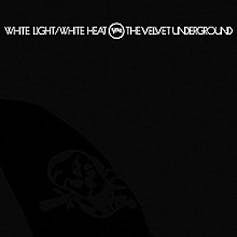White Light/White Heat: The Velvet Underground's monochrome obituary for the love generation
Mark Goodall examines the significance of The Velvet Underground's avant garde second album.
 thatspep, CC BY-NC Mark Goodall, University of Bradford
thatspep, CC BY-NC Mark Goodall, University of Bradford
Veteran CNN reporter David Axelrod recently described 1968 as a time of “chaos in black and white”. After the optimistic psychedelia of the previous year, events took a harsh turn as assassinations, riots and war unfolded on TV screens across the globe. Fifty years on, two music LPs from 1968 especially sum up Axelrod’s stark monochrome vision: The Beatles White Album, and White Light/White Heat, the second album from The Velvet Underground, the New York cult rock group previously managed by pop artist Andy Warhol. But it was White Light/White Heat that best anticipated the end of the hippy dream.
In reality, Warhol’s “management” of the group meant using them for his Exploding Plastic Inevitable (EPI) – a series of multimedia events across America. Featuring film screenings, fetish dancing and light shows, EPI was one of the first “happenings” – and Warhol placed the Velvet Underground at the centre of each event. He famously persuaded them to adopt German actress and model Nico as a singer, and funded their first LP, The Velvet Underground and Nico, released the previous year.
 Pop art icon, part-time band manager. Jack Mitchell, CC BY-NC-SA
Pop art icon, part-time band manager. Jack Mitchell, CC BY-NC-SA
White Light/White Heat was a break from both the Warhol circus and the lyrical beauty of their debut record. While their first album contained a few harsh moments (the “rushing” sections of Heroin and the improvised noise of European Son), a coarse, distorted sound totally dominated their second. The stark mood change is explained partly by the chemical and psychological landscape of the time.
The optimistic, fragrant and colourful manner of psychedelic music and art, as expressed in the previous two years (with The Beatles’ Sgt. Pepper at its zenith), was replaced by paranoia, depression and anxiety. And the tensions between group leaders Lou Reed and John Cale were nearing boiling point, exacerbated by dangerously extreme use of hard drugs.
Avant garde
The unapologetic sound, combined with deliberately deathly artwork, makes White Light/White Heat a very confrontational album. While The Beatles went for purity with their minimalist white Richard Hamilton-designed cover, a beautiful black-on-black image of a skull tattoo (Warhol’s final gift to the group) snarls out at you from theirs, and even the supposed “rock” tracks are disruptive and provocative.
 Simple cover, complex sound. Wikimedia Commons
Simple cover, complex sound. Wikimedia Commons
I Heard Her Call My Name contains, according to rock magazine Crawdaddy’s Wayne McGuire, “one of the most highly-charged moments ever heard in music” and features some of the most extreme guitar soloing of all time. Guitar greats such as Robbie Robertson would queue around the block to see Reed play, only to be disappointed by his perceived lack of “technique”.
On title track White Light/White Heat, a crunching bass cuts through a wall of distorted guitars, emerging at the end of the song as the sole survivor, while Moe Tucker’s drums are reduced to a swirling, crashing noise.
Other tracks are revolutionary in a different way – by blending experimental rock with the spoken word. In The Gift, a groove the band jammed to in live shows plays under a short story written by Reed at university, in which a man mails himself to his estranged girlfriend in an attempt to win her back. As you might expect, the ending is bleak, comic, and straight out of a Shirley Jackson novel.
Lady Godiva’s Operation is a disturbing, aural anaesthetic. The lyrics tell the legend of the famously naked Godiva, re-imagined as a cosmetic surgery procedure. Another groovy backtrack is augmented with a slowing pulse, deep breathing and sickening shudders straight out of a low-budget horror film. Both tracks are narrated by Cale – his Welsh lilt adding an extra dimension of strangeness.
Sister Ray said
But the most famous track on the album is Sister Ray – a raucous, 17-minute symphony of noise beneath another grim tale of New York’s underbelly. Here the Velvet Underground emulate the improvisation of free-jazz musicians Ornette Coleman and Cecil Taylor with, in the words of Reed, “a rock n’ roll feeling”. It is the epitome of the group’s art.
While other Velvet Underground LPs are now feted and revered, White Light/White Heat remains an enigma. It was virtually ignored on its release in June 1968, shunted aside, as Lester Bangs put it, “by safer, flashier music which eventually proved so stereotyped”. But with its harsh sound, strange technical effects, spoken word elements, improvisation and dreadfully poor production, it’s a unique entrant in the pantheon of classic rock.
![]() It became a catalyst for punk rock and New York’s subsequent “no-wave” movement. But imitators always lacked the group’s profound engagement with, and ability to combine, avant-garde aesthetics, literary modes of expression, experimental art and primitive elements of early rock and roll. Copycats never had the courage to go as far as Reed, Cale, Morrison and Tucker did on that second LP, and any future musician who does so will be brave indeed.
It became a catalyst for punk rock and New York’s subsequent “no-wave” movement. But imitators always lacked the group’s profound engagement with, and ability to combine, avant-garde aesthetics, literary modes of expression, experimental art and primitive elements of early rock and roll. Copycats never had the courage to go as far as Reed, Cale, Morrison and Tucker did on that second LP, and any future musician who does so will be brave indeed.
Mark Goodall, Head of Film and Media, University of Bradford
This article was originally published on The Conversation. Read the original article.
